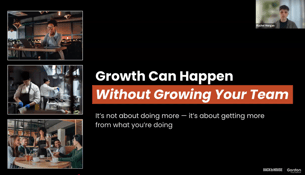Video editing, that invisible discipline, is how we arrange images and audio to create a story. From your original recorded clips (or “raw” footage), a strong online video ends up with a beginning, a middle, and an end. Even if the video is only 15 or 30 seconds long, you can craft a series of shots and effects to drive home its purpose. This craft is called editing. First and foremost editing is the technical process through which you turn raw footage into a finished and polished product. In the hands of a real master, it can become an art form in its own right. It’s how you get people to stop and really pay attention to that restaurant operator interview or unconsciously rewind and rewatch a promo video.
Editing is a necessary part of storytelling, content creation, and most social media, so having the ability to do it yourself can give you more control over your brand. And stealthily it’s perhaps the killer skill to have when making videos for people to view on their phones. “If we define movies as primarily a directors’ medium, and television belongs to writers, then online videos are the editors’ form,” proclaimed a 2021 Vulture story about the growing influence of editors.
Editing is also how we as creators offer the greatest amount of meaning in the shortest possible time. When I create food videos the editing phase is where I feel the most expressive — when I get to use music and to arrange my shots into a series of clips that take on a life beyond what they suggested before I stitched them together. The edit can be as complicated or as simple as your skill set and your vision allow. If you’re a novice, you can accomplish plenty with basic knowledge; as you grow, you’ll continue to push past your limits, making projects deeper and more creative as you hone your ability to shoot.
If nothing else, understanding edits will give you a greater appreciation for the people you hire to produce your videos, as well as a common language to share with them. “You can always outsource the task, but it’s great to have the skill,” says Kyung il Lee, a co-owner of Sagaponack, a seafood restaurant in New York’s Flatiron neighborhood. “If you know how to create content, then you know how to value it better.”
The growing popularity (and impressive quality) of phone cinematography has made it all the easier to find user-friendly editing software. Most of the phone apps out there are designed to accommodate even the greenest users, while allowing room for beginners to grow into amateurs. Like most technologies, video editing apps will feel more or less intuitive to different people, so your best software is the one that you feel most comfortable in — truly! If the user interface confuses you, find something that makes you feel at ease. Editing demands efficiency. A feature as seemingly banal as whether the buttons feel natural can make or break your experience.
Ultimately this is a matter of taste, so as you browse these programs, don’t be shy about trying a few out before deciding on one to sink your time into. Chances are you can nerd out on a free trial or slimmed-down version before you have to choose which to buy.
The best phone-based video editing apps and software
The video production available on phones these days floors me. I was trained on Avid, spent a decade using Final Cut, and have been dedicated to Adobe Premiere Pro for at least six years. The variety and scope of my projects require a desktop computer and professional program, but that doesn’t mean you need to go so big. A huge proportion of content creators work directly within their phones. Douglas Kim, the chef and owner of JeJu Noodle Bar, has really become a semi-professional video artist in his own right making original work for his restaurant, a Michelin-starred Korean-inspired standby in New York’s West Village. He chooses to work in Adobe Premiere Pro because he finds the color grading on phone apps is too limited. But even he has to admit: “Video made from iPhone goes more viral than pro video.”
If you want to work directly from your phone, here are some of the top programs to consider.
Cost: $70/year after a seven-day free trial (plus in-app purchases for templates)
This iOS app is what Kyung il Lee uses for videos of 15 seconds or less while he learns Adobe Premiere. The app’s design feels optimal for social media, intuitive for anyone who has edited directly in TikTok or Instagram reels, with wider options for transitions, filters, animations, and sound effects. You can also load video clips into templates, for speed and ease, or choose from some stock and rights-cleared music. (If you edit within Instagram or TikTok you can select current popular music without it being removed by the app.) For a similar option that works on Android phones, check out InShot.
Cost: Use Premiere Rush Starter for free, or level up a $10/month version with added features
This is the mobile answer to the professional-grade Adobe Premiere Pro. A lot of the functions were familiar to me (like how to separate audio from video tracks), so I was comfortable with this one. The program makes it simple to add titles, vary video speed, correct color, level your audio, add music, and clean up your voiceovers. The transitions and effects are somewhat more basic on Rush than on Videoleap, but I like that projects immediately start with format selection — horizontal, vertical, 1x1, and so on. You can also easily change the format mid-project.
If you buy Adobe’s subscription-based Creative Cloud, which includes the full desktop version of Premiere, you’ll find that your videos sync up with your computer and your phone, letting you edit and export clips from one to the other in a snap.
Cost: Free to download and use with basic functions, or $70/year (or $10/month) for VN Pro
This program feels like a mix between Videoleap and Adobe Premiere Pro. The timeline (the sequence of clips where you build your video projects) more closely resembles Premiere, but with transition options and templates similar to Videoleap. VN offers a good fit for anyone who exports videos directly to social media, with a wide range of template options for video and still photos. Standout for me were the font and animated photo options in its templates. For a similar option with even more effects and transitions, check out CapCut.
Some additional options and steps. At the very beginning, you might check out iMovie. It’s too basic for my taste, but comes pre-installed by default on most iPhones and will work in a pinch. At the other end of the spectrum is a program called LumaFusion. Geared towards professionals and journalists-on-the-go, it’s $30 to download and might be more than what you want to use on your phone per se (though on a tablet or laptop it might be just the thing).
And once you’re ready to level up your skills, I recommend going straight to the source: Adobe Creative Cloud has lots of great tutorials for their programs. Or check out Lynda (now a subsidiary of LinkedIn) and its 22-hour professional video editing course. Lots of small bites there if you want an introduction to facets of the process.
Simple tried-and-true video editing tips
Great, you have a program on your phone that will let you turn a series of clips into a mini-movie. Now you should bear in mind a few guidelines, to set yourself up for success when you actually go to use the app.
Plan every shot of the video before you press record. You will be the happiest version of yourself if you shoot with the edit in mind. The process of editing starts in pre-production, before filming even begins. When you’re capturing video, you film each shot thinking ahead to how you’ll use the shot in the final piece — a practice called “shoot to edit.” You’ve heard of storyboarding, perhaps in the context of making films or cartoons? It simply means planning out each shot you’re going to capture, and it’s a crucial planning step for even short videos, to prevent you from overshooting tons of footage to weed through later.
Keep your footage organized. Whether you’re using your phone or a standalone camera, make separate albums, label folders, and stick to a consistent naming system. Nothing’s worse than sifting through a barrage of random clips with names like Zip codes, hunting for the one shot among a hundred that you knew at the time was going to be essential.
Keep things simple. I spent many years working on a live daily television show, where I would be tasked with spitting out fully edited segments in a matter of hours (I think my speed record for a two-minute segment is 50 minutes). Now, it’s more like a few days to even a couple weeks. But I got really good at knowing when to move on, and that has stayed with me. It’s OK to set a time limit and keep things short, simple, and to the point.
Balance your audio. Listen to your timeline or edit project. If the music is too loud or distracting to the person speaking, adjust it where you can.
Edit to music. Editing your video clips to match beats on the music can completely change the feeling of the whole project. It seems simple, but is often overlooked.
Think beyond talking heads. When you as a viewer watch a video, you’ll usually hear someone speaking while seeing other secondary footage (what we call “b-roll”) on the screen. The truth is, no matter how interesting someone’s words are, your viewers pretty quickly prefer to see something other than the speaker. Capturing elements of the environment and editing the speaker’s audio over those shots helps viewers to understand what they are hearing (especially for us visual people).
Finally, when it’s all said and done, there really are no rules. Sure there are professional standards or ways to make things “objectively” excellent, but rules are made to be broken. And the beauty of working on your phone means you may think of things in a more free, creative and interesting way than a traditional method. If you’re going to edit your own videos, experiment with at least two programs, and pick whichever interface feels most natural to you. There is no wrong choice. And if it’s fun for you to watch the finished product, it’ll be fun for your audience too.
Kathryn Sheldon is an Emmy Award-winning photographer and director of photography based in Brooklyn, New York. You can find her work at kathrynsheldon.com.





